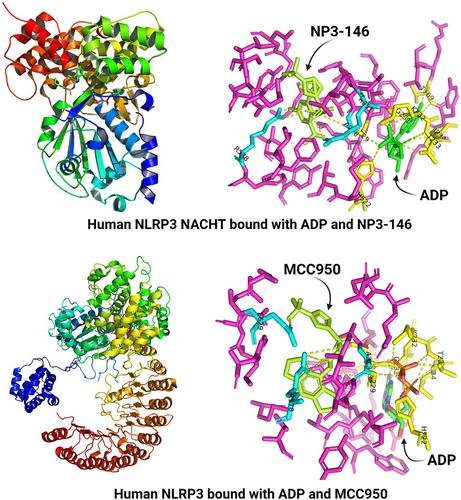当前位置:
X-MOL 学术
›
Pharmacol. Rev.
›
论文详情
Our official English website, www.x-mol.net, welcomes your feedback! (Note: you will need to create a separate account there.)
Pharmacological Inhibition of the NLRP3 Inflammasome: Structure, Molecular Activation, and Inhibitor-NLRP3 Interaction
Pharmacological Reviews ( IF 21.1 ) Pub Date : 2023-05-01 , DOI: 10.1124/pharmrev.122.000629 Qiang Ma 1
Pharmacological Reviews ( IF 21.1 ) Pub Date : 2023-05-01 , DOI: 10.1124/pharmrev.122.000629 Qiang Ma 1
Affiliation

|
The nucleotide-binding, oligomerization domain-like receptor family pyrin domain containing 3 (NLRP3) inflammasome is a multiprotein complex that combines sensing, regulation, and effector functions to regulate inflammation in health and disease. NLRP3 is activated by a diverse range of inflammation-instigating signals known as pathogen associated molecular patterns and danger associated molecular patterns. Upon activation, NLRP3 oligomerizes and recruits partner proteins to form a supramolecular platform to process the maturation and release of interleukin (IL)-1β, IL-18, and gasdermin D, major mediators of inflammation and inflammatory cell death termed pyroptosis. The NLRP3 inflammasome has been implicated in the pathogenesis of a wide range of disease conditions, including chronic inflammatory disease that are associated with lifestyle and dietary changes, aging, and environmental exposures, and have become the leading cause of death worldwide. Pharmacological targeting of NLRP3 and signaling demonstrated promising efficacy in ameliorating a list of disease conditions in animal models. These findings underscore the potential and importance of NLRP3 as a druggable target for treating a range of diseases. In this review, recent progress in understanding the structure and mechanism of action of the NLRP3 inflammasome is discussed with focus on pharmacological inhibition of NLRP3 by small molecule inhibitors. New structural and mechanistic insights into NLRP3 activation and inhibitor-NLRP3 interactions would aid in the rational design and pharmacological evaluation of NLRP3 inhibitors for treatment of human disease.
中文翻译:

NLRP3 炎症小体的药理学抑制:结构、分子激活和抑制剂-NLRP3 相互作用
核苷酸结合、寡聚化结构域样受体家族 pyrin 结构域包含 3 (NLRP3) 炎性体是一种多蛋白复合物,它结合了传感、调节和效应器功能以调节健康和疾病中的炎症。NLRP3 被多种炎症激发信号激活,这些信号被称为病原体相关分子模式和危险相关分子模式。激活后,NLRP3 寡聚化并募集伙伴蛋白以形成超分子平台来处理白细胞介素 (IL)-1 β的成熟和释放、IL-18 和 gasdermin D,炎症和炎症细胞死亡的主要介质,称为细胞焦亡。NLRP3 炎症小体与多种疾病的发病机制有关,包括与生活方式和饮食改变、衰老和环境暴露相关的慢性炎症性疾病,并已成为全球死亡的主要原因。NLRP3 的药理学靶向和信号转导在改善动物模型的一系列疾病状况方面显示出有前途的功效。这些发现强调了 NLRP3 作为治疗一系列疾病的药物靶标的潜力和重要性。在这篇评论中,讨论了了解 NLRP3 炎性体的结构和作用机制的最新进展,重点讨论了小分子抑制剂对 NLRP3 的药理学抑制。对 NLRP3 激活和抑制剂-NLRP3 相互作用的新结构和机制见解将有助于合理设计和药理学评估用于治疗人类疾病的 NLRP3 抑制剂。
更新日期:2023-04-21
中文翻译:

NLRP3 炎症小体的药理学抑制:结构、分子激活和抑制剂-NLRP3 相互作用
核苷酸结合、寡聚化结构域样受体家族 pyrin 结构域包含 3 (NLRP3) 炎性体是一种多蛋白复合物,它结合了传感、调节和效应器功能以调节健康和疾病中的炎症。NLRP3 被多种炎症激发信号激活,这些信号被称为病原体相关分子模式和危险相关分子模式。激活后,NLRP3 寡聚化并募集伙伴蛋白以形成超分子平台来处理白细胞介素 (IL)-1 β的成熟和释放、IL-18 和 gasdermin D,炎症和炎症细胞死亡的主要介质,称为细胞焦亡。NLRP3 炎症小体与多种疾病的发病机制有关,包括与生活方式和饮食改变、衰老和环境暴露相关的慢性炎症性疾病,并已成为全球死亡的主要原因。NLRP3 的药理学靶向和信号转导在改善动物模型的一系列疾病状况方面显示出有前途的功效。这些发现强调了 NLRP3 作为治疗一系列疾病的药物靶标的潜力和重要性。在这篇评论中,讨论了了解 NLRP3 炎性体的结构和作用机制的最新进展,重点讨论了小分子抑制剂对 NLRP3 的药理学抑制。对 NLRP3 激活和抑制剂-NLRP3 相互作用的新结构和机制见解将有助于合理设计和药理学评估用于治疗人类疾病的 NLRP3 抑制剂。






























 京公网安备 11010802027423号
京公网安备 11010802027423号